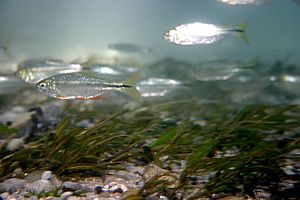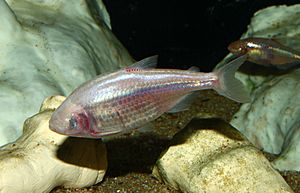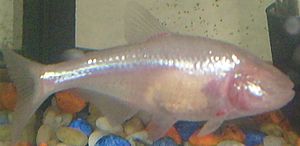Mexican tetra facts for kids
Quick facts for kids Mexican tetra |
|
|---|---|
 |
|
 |
|
| Mexican tetra, normal form (above) and blind cave form (below) | |
| Conservation status | |
| Scientific classification | |
 |
|
| Approximate range in red |
The Mexican tetra (Astyanax mexicanus) is a freshwater fish. It is also known as the blind cave fish. This fish lives in rivers and caves in Texas and Mexico. It is part of the Characidae family.
Mexican tetras can grow up to about 12 centimeters (5 inches) long. The regular form has a plain, dull color. But the blind cave form is special. It has no eyes and no color, looking pinkish-white like an albino animal.
These fish are peaceful. They usually swim in the middle of the water. They like rocky and sandy areas in creeks and rivers. Mexican tetras prefer water that is 20 to 25 degrees Celsius (68 to 77 degrees Fahrenheit). In winter, some groups move to warmer places. They eat small crustaceans, insects, and worms. In an aquarium, they will eat many different foods.
Scientists sometimes thought the Mexican tetra was a subspecies of another fish, A. fasciatus. But most don't agree with this idea. The blind cave form is also sometimes called a separate species, A. jordani. However, studies show they are the same species.
Contents
The Amazing Blind Cave Form
The A. mexicanus is famous for its blind cave form. People call it the blind cave tetra or blind cavefish. Some cave forms have poor eyesight, while others have lost their eyes completely. For example, fish from the Pachón caves have no eyes at all. Fish from the Micos cave can still see a little bit.
Even without eyes, these fish can find their way around. They use their lateral lines. These lines are very sensitive to changes in water pressure. This helps them "feel" their surroundings in the dark. Scientists found that blind cavefish have a bent skull. This bend might help more water flow to one side of their face. This could make their senses better for mapping out the dark caves.
About 30 groups of cave populations are known. They live in different areas of Mexico. Some caves have only blind, colorless fish. Other caves have blind fish, normal fish, and fish that are in-between. Studies show that these blind populations came from at least five separate times when surface fish moved into caves.
Studying Evolution in Mexican Tetras
The surface and cave forms of the Mexican tetra are great for studying evolution. When the ancestors of the cave fish moved into dark caves, their bodies changed. They no longer needed eyes because there was no light. This led to the loss of their eyes. This is called a "regressive trait" because the original fish had eyes.
But cave fish also developed "constructive traits." These are new features that help them live in the dark. Scientists are very interested in why traits like eyes disappear. Some studies suggest it's because losing eyes helps the fish in other ways. It might not just be random changes.
The blind Mexican tetra is different from the surface fish in several ways:
- It has no color in its skin.
- It has a better sense of smell.
- It has taste buds all over its head.
- It can store four times more energy as fat. This helps it survive when food is hard to find.
Charles Darwin wrote about sightless fish. He thought that if an organ like an eye was not used, it would slowly disappear. Modern science shows it's more complex. There must be a benefit for the eyes to disappear.
Here are some ideas why cave fish lost their eyes:
- Not growing eyes might save energy. This energy can then be used for growing or having babies.
- Without eyes, there is less chance of injury or infection. The useless eye area is covered by skin.
- Losing eyes might affect their "body clock." This clock is usually controlled by light and dark. Saving energy from this could be helpful.
Another idea is that in the dark, eyes are not helpful or harmful. So, any genetic changes that cause eye problems can spread. This happens because there is no pressure to keep good eyesight in the dark.
Some people who disagree with evolution use the cave tetra as an example. They say it shows "devolution," meaning things get simpler. But evolution does not always mean things get more complex. It means organisms change to fit their environment better. Sometimes, getting simpler is better for survival.
Mexican Tetras in Aquariums
The blind cave tetras you see in pet stores today all came from fish collected in a cave in Mexico in 1936. These fish were sent to a company in Texas. They then started to sell them to people who keep aquariums. Since then, these fish have been bred to keep their blind and colorless traits. Many are now bred in large farms, especially in Asia.
The blind cave tetra is a tough fish. Not having eyes does not stop them from finding food. They like dim lights and a rocky bottom in their tank. This is like their natural cave home. As they get older, they can become a bit aggressive. They are also schooling fish, meaning they like to live in groups. Studies show that keeping these fish in bright tanks does not stop the skin flap from growing over their eyes.
Images for kids
See also
 In Spanish: Astyanax mexicanus para niños
In Spanish: Astyanax mexicanus para niños







